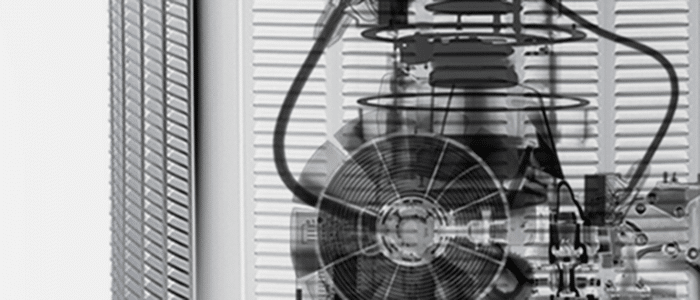
If you’ve ever shopped for a new air conditioner or furnace, you’ve probably seen energy rating data listed somewhere on the product. Knowing what those numbers mean, and how to compare them, can save you a lot of money over the life of your equipment.
Making sense of the numbers
Ratings help you make smart choices
Energy ratings were established to provide a baseline for comparing heating and air conditioning equipment based on the energy it uses to keep you comfortable. In a sense, you can think of energy ratings like miles-per-gallon in a car. The more gasoline it takes you to go one mile, the more you’ll spend for every mile you need to travel. So if you’re looking at a large SUV that gets 15 miles per gallon, you know you’ll need to plan a larger fuel budget every month than if you’d chosen a subcompact or hybrid car that gets 38 miles to the gallon.
What the ratings mean for your home
With home heating and cooling equipment, the efficiency numbers tell you how much energy you’ll have to spend to get the same performance out of similar products. Ratings are different for each type of heating and cooling equipment, simply because of the energy source used to power it. In other words, you can’t use the same rating to compare a gas furnace to an electric heat pump, because they don’t use the same type of fuel. However, when you understand the numbers behind the ratings, you can get a good idea of how much money you’ll spend to run your equipment, whether it uses gas, electricity, or both.
SEER, for rating electric cooling
SEER is one of the most common rating systems for home cooling equipment. It stands for Seasonal Energy Efficiency Ratio, and it gives a pretty good indication of your energy costs because it measures performance over an entire cooling season. To calculate SEER, you simply take the total cooling output that the equipment will generate over the summer, measured in British Thermal Units (BTU), and divide it by the total amount of energy you’ll have to expend (and pay for) during the same time period. What you’re really measuring here is how much cooling power the unit will provide, and how much it will cost you to enjoy that cool comfort. The Lennox® XC25 is currently the most precise and efficient air conditioner you can buy*, offering a SEER of up to 26. Federal law currently mandates a minimum SEER of between 13 and 14, depending upon where in the country you live, and any air conditioner over 14.5 SEER can be eligible for ENERGY STAR® qualification, meaning it’s a smart choice for energy-efficient cooling.
When you’re doing air conditioning installation in Omaha, NE, ask us what SEER rating is right for your home.
AFUE, for rating gas furnaces
AFUE is a different way to measure efficiency, because it deals with a different type of fuel. The AFUE of a furnace, which stands for Annual Fuel Utilization Efficiency, is a measure of how much heat is generated over the course of the heating season, compared with how much fuel is burned. AFUE is a fairly straightforward number. The higher the number, the more heat you will actually feel for a given amount of natural gas burned. A furnace with an AFUE of 80 will turn 80% of its fuel into useable heat, while wasting about 20% of its fuel through either air leaks, inefficient burners or a less-advanced design. On the other hand, a furnace with an AFUE of 95 will convert 95% of the gas it consumes into useable warmth. Any furnace with an efficiency of 90% or higher is considered high-efficiency. The Lennox SLP98V furnace currently offers an AFUE of 98.7, meaning it converts 98.7% of its fuel into useful heat for your home. With less than 2% fuel waste, it’s a very efficient way to weather the winter. (XC25/XP25) Efficiency claim based on comparison of air conditioning and heat pump products’ SEER as published in AHRI (January 2013). Actual system combination efficiency may vary; consult a Lennox Dealer or AHRI for exact system efficiencies. Precision claim based on the cooling capacity range of the XC/XP25-036 units as compared to equivalent-sized competitive variable capacity compressor units.
When you’re doing furnace installation in Omaha, NE, don’t forget to ask us about what AFUE rating is right for you.
HSPF, for rating electric heating and cooling
In the simplest terms, an electric heat pump is an air conditioner that can run in reverse. During the summer, it moves heat out of your home into the atmosphere. Then, during colder weather, it reverses the process and draws latent heat from the outside air into your home. Since it doesn’t use fossil fuel, AFUE really doesn’t apply. So heat pumps actually have their own comparative efficiency rating, known as HSPF, or Heating Season Performance Factor. This is a measure of how efficiently an electric heat pump can warm your home when it’s in heating mode, over the course of an entire heating season. HSPF is calculated by dividing the unit’s heat output over the course of the season by the amount of electricity required to produce that heat. Anything over 8 is considered high-efficiency, and may be eligible for utility rebates or tax credits. When shopping for a heat pump, it’s important to remember that since it uses electricity to heat and cool, it will have both a SEER and an HSPF rating since it runs during multiple seasons. The Lennox XP25 heat pump currently offers a SEER of up to 23.5, and an HSPF of up to 10.20.
